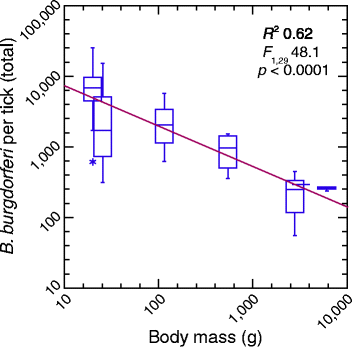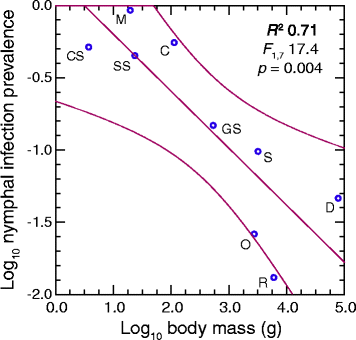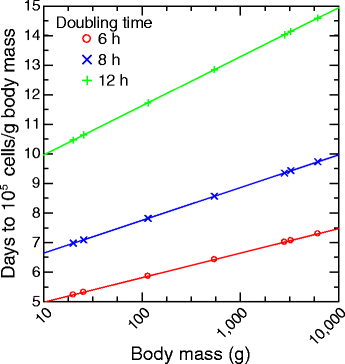Association between body size and reservoir competence of mammals bearing Borrelia burgdorferi at an endemic site in the northeastern United States
- PMID: 26024881
- PMCID: PMC4459683
- DOI: 10.1186/s13071-015-0903-5
Association between body size and reservoir competence of mammals bearing Borrelia burgdorferi at an endemic site in the northeastern United States
Abstract
Background: The reservoirs for the Lyme disease agent, Borrelia burgdorferi, are dominated by several different small to medium sized mammals in eastern North America.
Findings: To experimentally assess the competence of different mammalian species to transmit this pathogen to ticks, we carried out quantitative species-specific PCR of individual nymphal Ixodes scapularis ticks, which had been collected as replete larvae from animals captured at a field site in eastern Connecticut and then allowed to molt in the laboratory. The mammals, in order of increasing body mass, were the white-footed mouse, pine vole, eastern chipmunk, gray squirrel, Virginia opossum, striped skunk, and common raccoon. The prevalence of infection in the nymphs and the counts of spirochetes in infected ticks allometrically scaled with body mass with exponents of -0.28 and -0.29, respectively. By species, the captured animals from the site differed significantly in the mean counts of spirochetes in the ticks recovered from them, but these associations could not be distinguished from an effect of body size per se.
Conclusions: These empirical findings as well as inferences from modeling suggest that small mammals on the basis of their sizes are more competent as reservoirs of B. burgdorferi in this environment than medium-to large-sized mammals.
Figures



References
-
- Piesman J, Schwan TG. Ecology of borreliae and their arthropod vectors. In: Samuels DS, Radolf JD, editors. Borrelia. Molecular biology, host interaction, and pathogensis. Norfolk, UK: Caister Academic Press; 2010. pp. 251–78.
Publication types
MeSH terms
Grants and funding
LinkOut - more resources
Full Text Sources
Other Literature Sources
Medical

